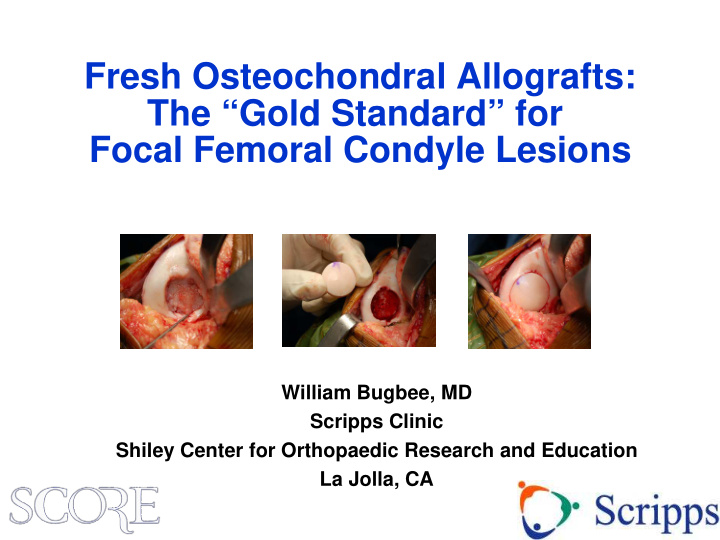



Fresh Osteochondral Allografts: The “Gold Standard” for Focal Femoral Condyle Lesions William Bugbee, MD Scripps Clinic Shiley Center for Orthopaedic Research and Education La Jolla, CA
Disclosure • Joint Restoration Foundation – Consultant, research support • Arthrex – Consultant • I have no IP related to osteochondral allografts – Everything I know is in the public domain • I have nothing against cell based therapy or any other cartilage restoration technique
Two Fundamental Strategies of Cartilage Restoration • Cell based – Induce cells to form (chondral) tissue in situ » Marrow stimulation/ MFx plus » (M)ACI » Minced tissue (alive or dead) • Whole tissue based – Restore defect with mature tissue » Osteochondral autograft (OAT) » Osteochondral allograft (OCA) » Processed (acellular) allografts
“Seed vs. Sod”
Subchondral Bone and the Osteochondral Unit • Integrated organ system • Interdependent structure- function relationship • Increasingly recognized in cartilage injury and repair
28 year old Basketball Player 2cm 2 MFC lesion, Previous meniscectomy
Osteochondral Allografting • Originally introduced as a joint reconstructive procedure for trauma, tumors and arthritis • Now widely used as a cartilage restoration technique for chondral and osteochondral lesions Cartilage repair paradigm Complex reconstruction paradigm •Microfracture • OCD •OAT • AVN •ACI • Post-traumatic •OCA
Clinical Outcomes Depend on Diagnosis Among patients with grafts in situ at latest follow-up Mean Mean OCA IKDC IKDC Diagnosis failure pain Function Satisfaction* Traumatic chondral injury 2% 3.3 7.3 90% Osteochondritis dissecans 7% 2.1 8.1 96% Fracture 15% 4.4 6.1 80% Degenerative chondral lesion 21% 3.7 6.3 81% Avascular necrosis 25% 2.7 7.1 92% Osteoarthritis 39% 3.5 5.8 79% *responded either “satisfied” or “extremely satisfied”
Osteochondral Allograft (OCA) “Modern Technique” • “Typical” cartilage repair indications • Traumatic chondral lesions, degenerative chondral lesions, OCD • Single defect • Precision surgical instruments • Dowel allografts utilizing the minimum amount of bone needed for fixation Technically easier to perform than shell grafts Advantages Bone transplantation kept to a minimum Fixation generally not required
Surgical Technique: Femoral Condyle
Surgical Technique: Femoral Condyle
Surgical Technique: Femoral Condyle
Patient Population 1983 – present N = 1,008 200 knees (187 patients) Primary knee OCA 1999 - 2014 N = 744 Single surgeon 1997 - present N = 557 Exclusions • Diagnosis of avascular necrosis • Anatomical location other than Met inclusion criteria femoral condyle N = 275 • Grafts located on medial and lateral femoral condyle in same knee • More than 2 grafts used ≥ 2 years from surgery • Shell grafts N = 225 Minimum 2 year follow-up N = 200
Demographics • Average age 31 years (range, 11 – 67) • 63% male • 86% had previous surgery on operative knee • Median 2 previous surgeries (range, 1 – 13) • Diagnosis 14% Osteochondritis dissecans Degenerative Traumatic 23% 63%
Graft Details • Femoral condyle location Medial (69%) Lateral (31%) • Mean total graft area 6.3 cm 2 (range, 2.3 – 13) • Mean graft thickness 6.5 mm (range, 5 – 11) • Number of grafts 1 (73%) 2 (27%)
Subjective Outcomes
Results: Reoperations Reoperations Reoperations Reoperations 26% (52 of 200 knees) 26% (52 of 200 knees) 26% (52 of 200 knees) Not related to allograft Not related to allograft Allograft failure 18% (36 of 200 knees) 18% (36 of 200 knees) 8% (16 of 200 knees) Examples: Examples: Allograft revision (4 knees) Diagnostic arthroscopy Diagnostic arthroscopy Arthrosurface (1 knee) Debridement Debridement Loose body removal Loose body removal Uni knee arthroplasty (6 knees) Plate/screw removal Plate/screw removal Total knee arthroplasty (5 knees) Meniscus repair Meniscus repair Osteotomy Osteotomy
Survivorship 96% 5 years 91% 10 years
Patient Satisfaction at Latest Follow-up 100% 89% satisfied 80% 68% 60% 40% 21% 20% 6% 3% 2% 0% Extremely Satisfied Somewhat Somewhat Dissatisfied satisfied satisfied dissatisfied
Return to Sports After OCA Unable to perform any activities 1.8% Fair function Did not Light 10.3% return to activities Very sports Excellent Good 19.7% strenuous 24.8% function function activities 36.7% 18.6% 37.2% Moderate Returned activities to sports Very good 25.0% Strenuous 75.2% function activities 34.4% 16.3% 78.5% 75.2% 71.1% able to participate in returned to very good to high lev&77el of excellent function sport activity
“Modern” Allograft Surgery Cartilage Repair Paradigm • 6 year mean f/u (2-17) • 6 cm 2 mean graft size • 6 mm mean graft thickness • 8% failure • 26% total reoperation • 75% return to sport • 90% ten year survivorship • 90% satisfaction Why do anything else?
Thank You “Those who have data need not shout”
Clinical Outcome
Recommend
More recommend